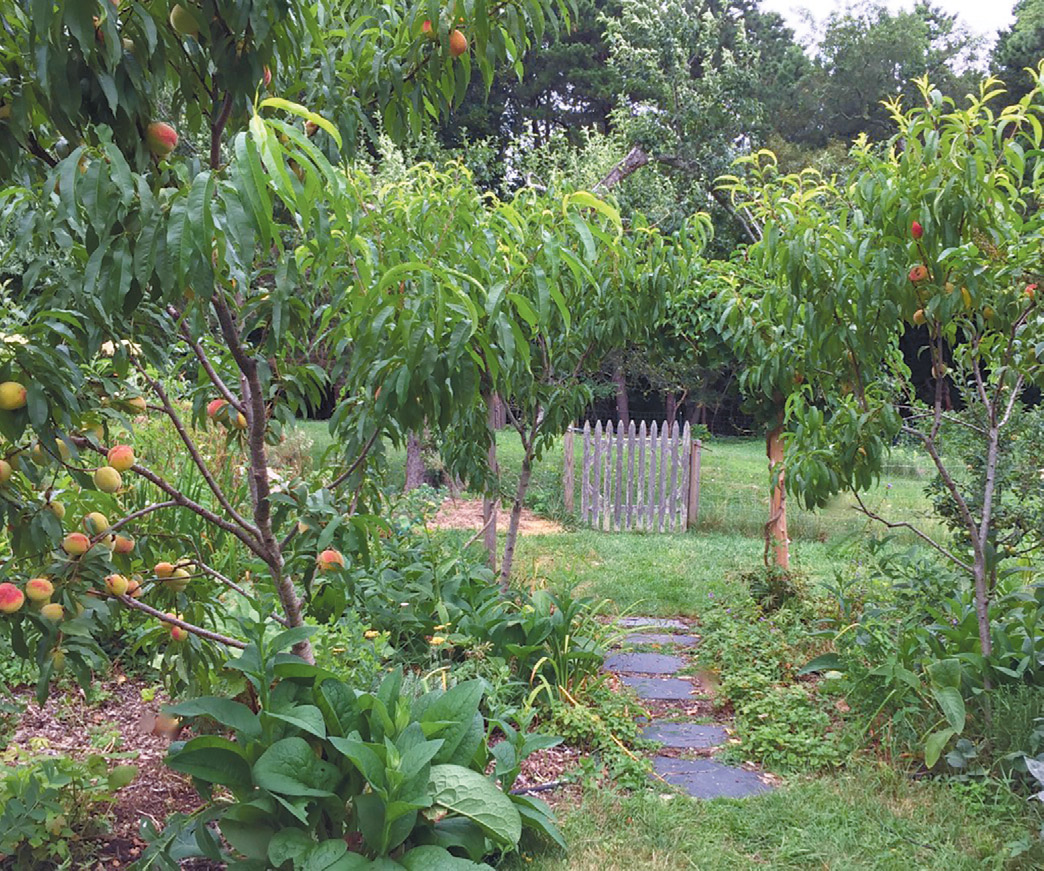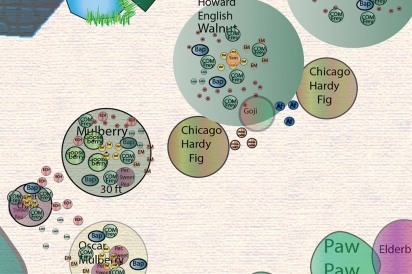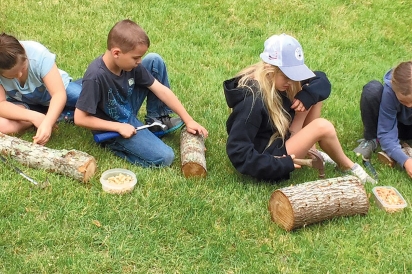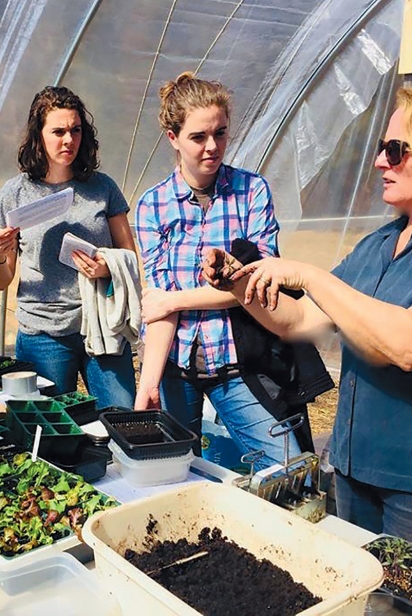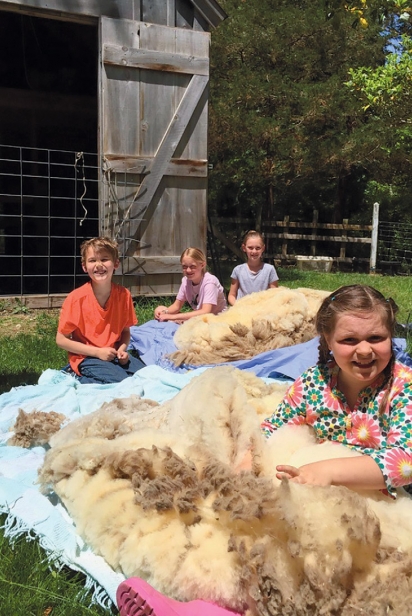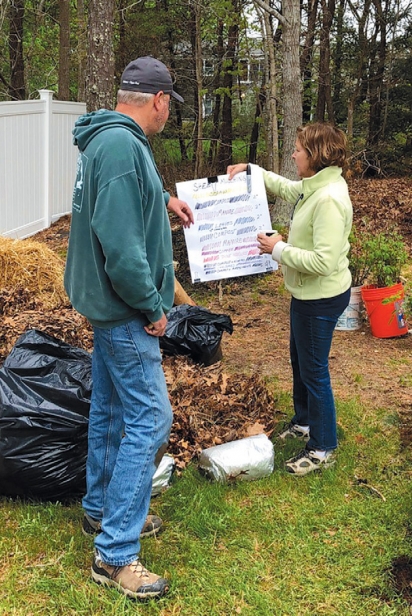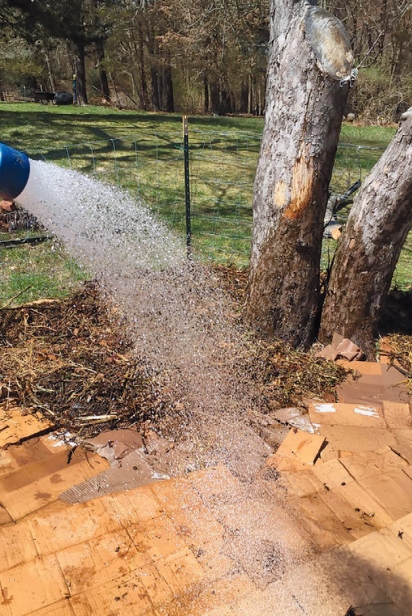Farming Naturally: Resilient Roots Shares the Wisdom of Permaculture
This may come as a bit of a shock to you, but we’re doing it wrong. Whether it’s a few small garden beds that you faithfully tend, or you’re a more ambitious backyard farmer, the way we go about raising crops is all wrong. Even the large-scale industrial farms are not practicing proper land management and are the biggest culprits. Luckily, there is Resilient Roots, a non-profit organization on Cape Cod that helps educate and train both the established farmer and the green seedling of a grower in the practice of permaculture.
After working as a marine ecologist for the state of Massachusetts, Kristie Kapp wanted to stay closer to home and her two young children. She turned to farming and has been helping people start their own farms for years. Along the way, she became aware of a different way to grow. It’s a practice called permaculture. Kapp became a Certified Permaculture Designer five years ago, to go along with the Master’s Degree in Environmental Management she earned at Yale in the 1990s. “I learned in depth what the permaculture ethos was all about,” says Kapp.
Bill Molinson, an Australian ecologist and professor at the University of Tasmania, and his student David Holmgren, originally conceived and coined the term “permaculture” in the 1970s. Permaculture is a set of concepts that mimic the resiliency of natural ecologies. An ecosystem is an intricate web of plant and animal life that supports sustainability. Permaculture is the study and practice of developing a human-made symbiotic network of plant life so that all can thrive. This can include trees, shrubs, vines and groundcover, all working together.
What happens now it that humans come along and strip away all competing vegetation to plant one crop. That’s not how nature intended for things to go. When was the last time you stumbled upon a naturally occurring cornfield? Did Lewis and Clark write about the vast and wondrous expanses of soybeans they came across on their march westward? Of course they didn’t, because that’s not how nature works.
What Molinson and Holmgren began over 40 years ago has grown to become a global movement with projects that number in the thousands. Everything from the small scale, that can fit on a balcony or rooftop, to the large, involving entire communities. On Cape Cod, Resilient Roots is educating people about how they can grow their own food by mastering some permaculture techniques, and also why we should be changing our thinking when it comes to agriculture.
Resilient Roots assists growers in building their own closed-loop system consisting of multi-layered perennial plantings that occur in nature. These seven to nine levels of plants, working together, can become self-sustaining in a few short years. The output of one level becomes the input for another. Fruits, leaves and twigs break down to become fertilizer and replenish the soil. Groundcover chokes out invasive weeds. Over time, the farmer’s need to maintain the area diminishes. No need to weed or feed as the network takes care of itself. All that’s left to do is harvest!
It all starts with an evaluation of the site in question. What is the topography and how does it hold and shed water? Planting across a slope will allow rain to water the plantings as it runs off from high point to low. How does the sunlight move across the site throughout the year? What is the climate like, and are there any microclimates on the property? Some areas that are only feet away from one another can be in completely different hardiness zones. “I have daffodils that come up early because they’re along a rock wall,” Kapp explains. “The rocks heat up in the sun and it’s much warmer than in other spots.”
One aspect of gardening that permaculture looks to eliminate is the need for tilling the soil. One of the first steps in traditional cultivation is to turn over the soil in preparation for seed sowing. Tilling is actually harmful to the soil, because it turns up the microbes within it and exposes them to the air. This kills off some beneficial microorganisms and releases the carbon locked in the soil. Once the carbon comes into contact with the air, it’s available to be turned into carbon dioxide and released into the atmosphere. Tilling soils on a large scale is a major contributor to climate change. Killing off the microbes in the soil is akin to humans ingesting antibiotics: wiping out the beneficial bacteria in our guts along with killing off the harmful ones.
Another growing global concern is the erosion and degradation of topsoil. Wind and water erosion are stripping away the fertile earth, assisted by today’s factory farming practices. According to David Pimental, Professor Emeritus of Agriculture and Life Sciences at Cornell University, soil erosion is second only to population growth as the biggest environmental problem the world faces. The United States is losing topsoil ten times faster than it can be replaced. Take into consideration that it can take up to 500 years to replace one inch of topsoil, and you get a pretty bleak picture of how things look going forward. India and China are losing soil 30-40 times faster than the replenishment rate! Tillage degrades the quality of the soil, and that fertility needs to be replaced chemically. The erosion washes away the soil into gullies, streams and rivers, and the chemicals are swept away with it. They become sediment, and poison bodies of water in which they end up. This ultimately creates a “dead zone” where low oxygen levels can kill fish and marine life. In 2017, the National Oceanic and Atmospheric Administration (NOAA) measured the “Dead Zone” in the Gulf of Mexico to be over 8700 square miles, or roughly the size of New Jersey. According to a study in Science, there are 405 known dead zones around the world. There were only 49 in the 1960s. As Kapp says with a wry huff, “We’re something, aren’t we?”
Sheet mulching (or sheet composting) is an answer to tilling. It supplements carbon and nitrogen in the soil as the multi-layered “lasagna mulch” breaks down. Layers of carbon-based material (starting with paper or cardboard to act as a weed barrier) are alternated with layers of nitrogen sources like manures, seaweed, vegetable scraps, etc. A final covering of a carbon layer (wood chips or straw) tops off the mulch and decomposition begins, becoming a nutrient rich soil in which plantings will thrive.
Throughout the warmer months, Resilient Roots hosts workshops on various subjects. A list of the 2019 workshops is on their website (resilientrootscapecod.org) and it includes “Getting Started with Raspberries, Blackberries and Blueberries”; “Introducing Edible Plants to Your Landscape”; “Foraging Your Weeds”; “Growing Shiitake Mushrooms on Logs” and a tour of a permaculture garden in progress and a plant sale. Last year, they even hosted an introductory workshop on cultivating cannabis, now that it is legal in Massachusetts to grow your own marijuana plants.
Resilient Roots offers design services to help homeowners envision what their own properties can look like when incorporating permaculture methods. There are two levels offered: a permaculture consultation, or a complete permaculture design, which includes drawings and reports. It is these consultation and design services that support the educational programs. The fees for these services work on a sliding scale, and Resilient Roots has reached out to local agencies that work with low-income families. “We believe that growing your own food shouldn’t be something just for the wealthy,” Kapp states. Indeed, growing one’s own food doesn’t need to be a costly endeavor. “There’s so much people can do using local resources,” she points out. Why buy expensive fertilizer when you can visit a friendly nearby horse owner for some manure? Not friends with a horse owner, you say? Here’s how you become friends with a horse owner: 1) ask a horse owner if you can unburden her/him of some manure; 2) load up as much manure as you want when they gleefully agree; 3) enjoy your newfound friendship when they tell you to come back anytime. After all, there will be plenty more.
The beach is another abundant source of fertilizer. Seaweed is extremely beneficial to plantings for a few reasons: it’s a great fertilizer for the plants, it’s a mulch that helps to keep the soil moist, and it acts as a pest control, as critters can’t stand it! The Town of Barnstable has no regulation against harvesting seaweed, but it’s a good idea to check with your town before taking a rake to your favorite beach and helping yourself. If you do go, a burlap sack is an ideal way to transport the seaweed, because it lets the water drain out, thereby lightening the load.
In 2019, Resilient Roots plans on performing up to five Permablitzes, where a team of volunteers descends on a property to create landscapes that are abundant and sustaining. It’s much like an old fashioned barn raising; many hands make light work. The group learns the permaculture techniques employed to craft these spaces, with the idea of one day perhaps recreating something on their own property. It takes about a month to prepare for a Permablitz. Site evaluations, consultations and drawings need to be worked up before the host can purchase the materials to be planted on the big day.
The blitz is managed by Resilient Roots’ board of directors, who lead small groups in various aspects of the build, often stopping for a mini-workshop on a specific issue. It helps break up the day and ensure that the volunteers aren’t just manual labor; it’s a valuable hands-on experience and they are there to learn. Some helpers are future Permablitz hosts. “We want hosts to come and participate in two or three Permablitzes before hosting one so they get an idea what’s involved,” Kapp explains. The results can be impressive, as mere lawns or uncontrolled areas are transformed into perennially-yielding ecosystems. Nut-bearing trees, dwarf fruit trees, berry bushes, and perennial vegetables and herbs as groundcover become beautiful and beneficial to the homeowner for years to come. Not that Kapp has anything against lawns. “You have to have them,” she points out. “Our son grew up playing sports and throwing the ball around. You need a lawn to do that.” Going forward, Kapp would love to renovate larger municipal properties like school grounds, where more people can learn of the beauty and benefits that permaculture offers.
“I’ve always loved to educate people,” Kapp states with a smile that never seems to leave. This love of education and farming combine in the most agreeable way, and two years ago Resilient Roots was born. Last year the organization received its 501(c)(3) designation. “I was looking at other places and just decided to start it here,” Kapp says of her own West Barnstable farm. The education is open to everyone. Resilient Roots offer kids farming classes where wee planters learn the basics and have fun at the same time growing mushrooms on logs and tending to the chickens. Last year they were even able to help out with sheep shearing.
With their roots now established, the organization is looking to grow. Resilient Roots has a network of about 300 people that Kapp reaches out to about attending workshops and permablitzes. She’d love to see that number grow, along with the staff of the organization. Right now, a great many things fall on Kapp’s shoulders. “So much of this is new to me,” she points out. “Taxes, grant writing, social media, there’s so much to do!” Like it is with so many small business owners, the business side of the endeavor can take one away from the aspects of the job that they love and the reason they began the venture in the first place. “I’m passionate about talking and teaching people, not social media,” she chuckles. The longer-range plans include finding a new space for the organization, and moving it out of Kapp’s home and farm.
Every problem has a solution, and for the approaching calamity that the world’s topsoil faces, a solution is permaculture. As with many revolutions, it’s best to start small. Factory farms won’t be altering their procedures anytime soon, but on a smaller scale, permaculture, and the related “forest farming”, are taking hold. These are not new practices. They date back decades even before the term “permaculture” was devised. There now seems to be a renewed push to advance them throughout the world, and not a moment too soon. Trying to bend nature to man’s will is proving to be a fool’s errand. There is a better way, and nature has been showing it to us all along.
resilientrootscapecod@gmail.com


